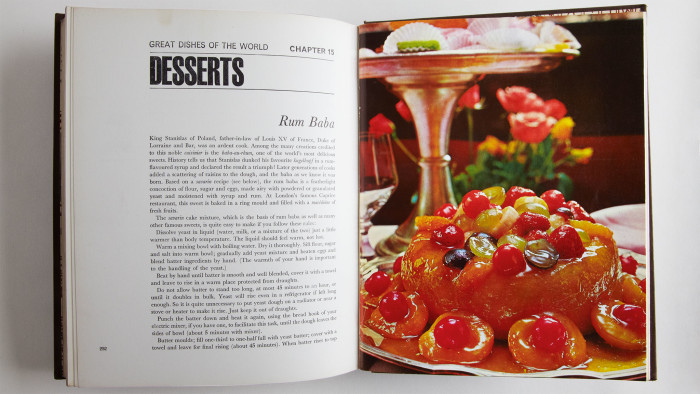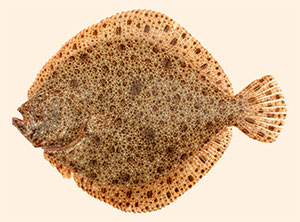The history cook: Great Dishes of the World

Roula Khalaf, Editor of the FT, selects her favourite stories in this weekly newsletter.
Great Dishes of the World, by Robert Carrier, 1963, Thomas Nelson & Sons
In the 1970s kitchen of my childhood, Robert Carrier’s Great Dishes of the World stood out. Shelved alongside the slim paperbacks of Elizabeth David, Alan Davidson and Jane Grigson, Carrier’s large hardback book with its extravagant photographs and ambitious title suggested that eating might be glamorous and fun. In a family where pudding consisted, if you were lucky, of homemade yoghurt, the photograph of a glistening fruit-and-syrup-coated rum baba on page 252 was nothing less than pornographic. I loved Great Dishes of the World when I was a child and I still do today.
Born Robert McMahom in Tarrytown, New York in 1923, Carrier later took his grandmother’s surname – he liked its French-sounding ring. Following a stint as an actor, Carrier came to the UK with the US armed forces in 1943. After the war he lived in France, working at a restaurant called Chez Fifine. This was the only professional cookery training he ever had. In 1953 he visited London for the coronation and landed the job of food editor and writer at Harper’s Bazaar. England became his home for most of his life.
Flamboyant and wedded to luxury, Carrier was the Liberace of the domestic kitchen. According to culinary commentators, the higher echelons of the fooderati regarded him with disdain. His tongue-in-cheek self-promotion, his love of superlatives and his camp presentation challenged the boundaries of taste in postwar Britain. He persuaded the housewives of a recently rationed nation that cooking was fun, eating a pleasure and garlic a blessing. Great Dishes of the World sold more than 10 million copies.
Based on a series of articles commissioned for the then new Sunday Times Colour Magazine, Great Dishes of the World is sumptuously made, with full-page photographs shot up-close. They tell a story and create a mood – an artichoke presented three ways against a black background dramatically but simply celebrates the raw ingredient. The sumptuous four-layered hors d’oeuvres trolley from London’s Etoile Restaurant positions the reader as diner and invites them to tuck in.
Great Dishes of the World was written well before the travel boom of the 1970s and eating-out explosion of the 1980s. It provided readers with an opportunity to emulate restaurant food in their own kitchens and to “travel without any of its inconveniences”. In Carrier the reader has a generous gastronomic guide. He invites the reader into his elite world, willingly sharing his expertise and tips: “All food should be eaten fresh …fish caught fresh from the coastal waters of St Tropez makes a better bouillabaisse than those kept on ice in the best Paris restaurants.” He also encourages practice and perseverance: “Do not be disappointed if you are unsuccessful at the first or even second attempt …recipes are not like doctors’ prescriptions; they cannot be repeated too often.”
Although revolutionary when it was published, Great Dishes of the World is very much a product of its time. Carrier’s requirements for the “emergency shelf” such as spaghetti and anchovies remain essentials today – less so, turtle soup, tinned ham and tinned cherries. Many recipes in the book also demand heart-stopping quantities of brandy, butter, cream and wine, and Carrier’s gastronomic world is intensely Eurocentric. Classic French dishes such as turbot au champagne and côte de veau normande dominate but the influence of Italy, Spain and Germany is clear, too. America is well represented with dishes such as New England boiled dinner, meatloaf and creole jambalaya. Other cuisines, however, are limited to the odd dish: Caribbean lamb, Moroccan skewered lamb or Chinese pork and lobster balls in sweet-sour sauce. A more accurate title might have been Some Great Dishes from Some Parts of the World.
By the time Carrier died in 1996, he had produced more than 20 cookery books, owned a PR agency, run two restaurants, a hotel and cookery school, and lobbied successfully to change licensing laws. His achievements were many but it is Great Dishes of the World that encapsulates the very best of Carrier – ebullient, enthusiastic, stylish and ambitious. And the rum baba looks just as good today as it did 30 years ago.
Polly Russell is a curator at the British Library; ‘Great Dishes of the World’ by kind permission from the British Library collection
——————————————-
Turbot au champagne

Serves four
4 turbot fillets, boned and skinned
½ lb butter
2 tbsp olive oil
2 shallots, finely chopped
½ lb button mushrooms, sliced
6 tbsp fish stock made from
Fish trimmings
½ quarter bottle of champagne
Salt and white pepper
½ pint double cream
1 level tbs cornflour
● Melt half the butter in a large shallow saucepan with olive oil; sauté finely chopped shallots until transparent; add sliced mushrooms and continue cooking until tender.
● Remove; add remaining butter and sauté turbot until lightly coloured.
Add mushrooms and onions, fish stock and half the champagne, adding more if necessary and barely to cover the fillets. Season to taste and simmer for a few minutes until tender.
● Remove fillets to a serving dish and keep warm. Add cream to the liquid in the pan; let simmer until cream is warm. Mix cornflour with a small amount of water, add to the sauce and stir constantly over a very low heat until sauce is rich and smooth.
● When ready to serve, stir in remaining champagne. If you prefer a thicker sauce, use less champagne. Pour over the turbot fillets and serve immediately.
Comments